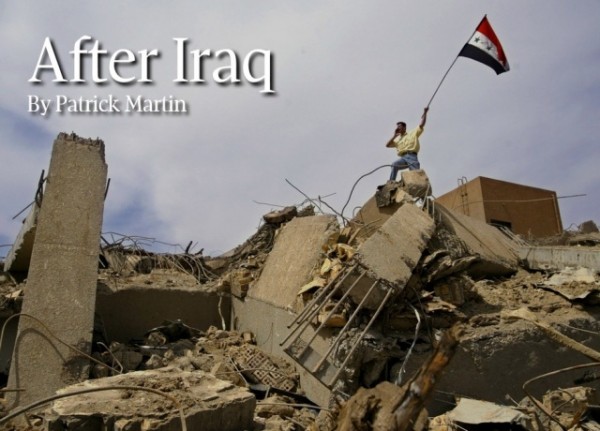
A protester waves an Iraqi flag atop the rubble of a house in central Baghdad, Friday April 18, 2003. (AP Photo/Lefteris Pitarakis)
ishtartv.com-
usnews
PATRICK
MARTIN
Most
Iraqis alive today have never known a time when their country was at peace.
They’ve endured war with Iran that killed a million people, genocidal campaigns
against Iraqi Kurds and Shiites, a decade of punishing economic sanctions, two
Gulf wars that led to U.S. occupation, years of sectarian fighting, and now
occupation of more than a quarter of the country by the radical jihadist group that
calls itself the Islamic State.
That
fighting has taken place on a fractured map, an Iraq that has always been
divided into thirds: the south, populated by rural, religious Shiites; the
north, a mountainous preserve of secular Kurds; and the centre of the country,
a more urban area dominated by Sunni Muslims in a band that stretches from
Baghdad to Mosul. This middle region is where political power resides, where
ancient civilizations thrived, where arts and culture flourished, and where
higher education has been more secular than religious.
The
sum total of all the violence, however, is redrawing the boundaries, shifting
the regions of power, and threatening the country’s very identity. The U.S.-led
coalition against Islamic State group, a coalition that Canada joined in
September, is contributing to these dramatic changes. In the course of
defeating the extreme IS brand of Sharia rule and its grisly means of executing
captives, the once vibrant Sunni population could well be expunged, and a new
Iraq may emerge: one that will be increasingly devoted to Shiism and will lean
heavily on Iran. Such an extension of Iranian influence will bring new
challenges to a West that is fearful of Tehran’s nuclear ambitions and growing
regional power.
The
old order was first shaken when U.S. forces occupied Iraq in 2003, defeated
Saddam Hussein, and ordered the dissolution of the Iraqi military and the
removal from government of all members of the ruling Baath Party.
A
decade later we are seeing the consequences: The purge left an administrative
vacuum, one that was filled by the growing majority of Shiites eager for power.
Many Shia leaders and militiamen had spent years outside Iraq, taking refuge in
Iran from Saddam’s blood lust, and wanted revenge. Their heavy-handed treatment
of Sunnis incited the deadly sectarian conflict of 2004-07 in which tens of
thousands died. Frightened Sunnis, lacking militias like those of the Kurds and
Shiites, turned to extremist groups to protect their neighbourhoods and attack
their Shia enemies.
Those
radical Sunni groups would lead eventually to today’s Islamic State movement
that occupies not only much of Iraq but also a large swathe of Syria. Such
brutal behaviour as the recent murder by IS jihadists of a Jordanian pilot by
burning him alive continues to strike fear and provoke rage across the region.
if
the coalition and Iraqi forces succeed in defeating the so-called Islamic State
– which is also sometimes referred to as ISIL or ISIS – some have predicted the
breakup of Iraq into three independent states: Shia, Sunni and Kurdish. But if
present trends continue, there may not be enough Sunnis to constitute a state;
Iraq’s future may more likely include only a Kurdish state in the northeast,
and a Shia state in the south and west. The Shia state, which would contain
some of Shiism’s holiest sites, is apt to become an Islamic republic, closely
allied to neighbouring Iran.
Travelling
through Iraq, one sees clear signs that the power, investment and
infrastructure are already moving to the Shia south and the Kurdish north –
both enjoy large deposits of oil – while the central part of the country is
being hollowed out.
Traumatized
by their loss of power, terrorized by Islamic State movement’s brand of radical
Islam, millions of Iraqis – mostly Sunnis and Christians – have fled their
homes in the cosmopolitan city of Mosul, as well as in Samarra, Fallujah and
Tikrit and many other towns and villages. Slowly but surely, Shiites are
filling the void.
Even
tribes composed of both Shias and Sunnis that have stayed behind, fighting for
a country they want to save, are being torn apart from the inside, with Sunni
tribesmen who support Islamic State fighters turning on their Shia cousins.
“This disease makes people ready to kill their own father,” says Sheik Nadeem
Hatem Sultan al-Tamimi, head of the large Tamim tribe in central Iraq. He lives
with his three wives and the youngest children from his flock of 21 in a modest
but well-guarded compound in Taji, north of Baghdad, just a few kilometres from
the front lines that stand between the Islamic State jihadists and the Iraqi
capital.
For
a Sunni presence to be maintained inside Iraq, two things would have to happen:
Islamic State movement must be defeated, and the Sunnis must return to their
homes. The first is possible, although it may take a year or two; the second is
not likely.
“We
are in a steep downward slide,” says Sheik Nadeem, 62, one that began with
Saddam Hussein’s 1990 invasion of Kuwait and the first U.S. war against Iraq.
“Since then, it gets worse and worse.”
“There’s
decay in the country – an absence of law and order,” he explains. “Gangs kidnap
people for ransom; no one is safe on the street.” The result, he said, is that
“people hide, and whoever is able has left the country.”
The
Shia ascendency
Freed
from Sunni rule by the election of Shia-dominated governments, the Shia south
of Iraq is coming into its own, benefiting from its enormous oil reserves that
have come back into production after several years.
A
new international airport is doing booming business in Najaf, one of the most
important pilgrimage sites in Shia Islam; and the city of Karbala, with another
important shrine, is thriving. There’s a new mall, several high-rise hotels,
and billboards advertising expensive new developments.
Young
people in these Shia areas enjoy listening to the radio, which plays religious
poetry and Koranic verses; take in religious festivals; and volunteer to serve
in Shia militia units. There are no cinemas or concerts to tempt them.
Shia
militias such as the Badr Brigade, along with Shia control of the Iraqi
military and support from Iran, have guaranteed security in this region lately.
But Shia leaders are taking no chances and have dispatched their militias to
take the fight to Islamic State movement.
At
the end of January, the Badr Brigade had celebrated the defeat of IS forces in
several towns in Diyala province, northeast of Baghdad. In the course of
battle, numerous Sunni residents were killed and a number of Sunni mosques
destroyed. The militias reportedly have no intention of letting the Sunni
population in the area return to their homes.
Shiites
see the rise of jihadists like Islamic State as part of a wider Saudi-backed
movement that is the Shiites’ eternal enemy. “They have to be stopped,” said
Layla Khafaji, a Shia member of Iraq’s parliament.
The
split in Islam began immediately after the death of the Prophet Mohammed, in
the seventh century: The Prophet’s family claimed that the leader of the faith
should descend from Mohammed, beginning with Ali, his cousin and son-in-law
(hence Shi’a, meaning followers of Ali). The unrelated companions of the
Prophet opted to elect the next leaders from among themselves (hence Sunni,
meaning followers of the traditions of the Prophet).
The
division turned hateful three decades later when Sunni leaders had Ali
assassinated at his headquarters close to Najaf in what is now southern Iraq.
They then defeated his son, Hussain, in a battle at nearby Karbala, beheading
him and murdering most of his family. Mourning for the loss of Hussain and his
family is marked every year on an emotional day of sorrow known as Ashura that
forms a central, distinctive feature of Shiism. Sunnis, who constitute 80 per
cent of Muslims, view such Shia practices as heretical, though only extremist
movements like Islamic State act on their antipathy.
Today’s
jihadists, with their reign of terror and decapitations are “behaving exactly
the way Sunnis did 1,400 years ago when they massacred the family of Imam
Hussain,” Ms. Khafaji says. “It’s the same mentality.”
Ms.
Khafaji, 57, who wears an ankle-length black abaya and a colourful head scarf
pulled tight around her face, experienced the terror of Saddam’s Sunni regime.
Coming
from a farming family in southern Iraq, Ms. Khafaji had been a star student at
university in Baghdad. She graduated in 1981 as an electrical engineer, one of
the few women in such a profession at that time. But she refused to join the
ruling Baath Party, and found it impossible to find work. Eventually, she was
forced to sign an “execution agreement”; by its terms, she agreed to be
executed should she ever join an organization opposed to the government. Only
then did a government-assigned position come her way.
Three
months into the job, however, she was arrested, tortured for several months and
convicted of anti-government activity – she had visited a woman whose brother
was in prison. The death sentence she received in 1983 was commuted to life
imprisonment, and she spent nine more years in jail.
Following
Iraq’s defeat in Kuwait, the regime was pressured to release political
prisoners, and Ms. Khafaji walked free. She fled the country for Canada, where
she was given refuge. When Saddam Hussein was ousted in 2003, she left Toronto
to work for the Islamic Supreme Council of Iraq, a Shia political party that
won the second-largest number of seats in the 2014 election.
She
says she has found her calling – she’s determined never to let a narrow Sunni
regime take power again.
The
Sunni position
The
Islamic State organization has its roots in Iraq. It started out as al-Qaeda of
Iraq a decade ago, dedicated to fighting the U.S. occupation. It then changed
its name to Islamic State of Iraq and launched several attacks on Christian
churches and Shia festivals. It moved its base of operations into Syria when
the civil war broke out there in 2011, broke from al-Qaeda, and called itself
Islamic State of Iraq and al-Sham. Last year, thousands of its fighters moved
back into Iraq as part of a blitz attack in which a quarter of Iraq, including
Mosul, the country’s second-largest city, was overrun in the span of a few
days.
Anyone
who doesn’t follow the IS interpretation of the true path of Sunni Islam is the
group’s target. It has laid waste to churches and Shia mosques, executed
thousands of people of all ages, enslaved hundreds of women from minority
sects, and successfully resisted most counterattacks to date.
A
senior Sunni imam at the 1,000-year-old Abu Hanifa mosque in Baghdad’s
Adhamiyah neighbourhood insists that people must understand what provoked Sunni
Iraqis to support Islamic State movement: Iran, the pre-eminent Shia state,
which borders Iraq on the east, is running things here, complains Dr. Abdul
Wahab al Samari, 41. “Our country’s military is completely dominated by the
Shiites … and we have no [Sunni] militia to turn to for help.”
Indeed,
Shia religious posters and banners are prominently displayed at Iraqi military
bases and checkpoints throughout the country, underscoring the religious bias
of these national institutions. And, because the Iraqi army is still not
capable of tackling the jihadists on its own, Shia militias often fight
alongside or instead of regular forces, adding to apprehension in the Sunni
areas in which they are battling.
“People
hear about [Islamic State fighters] burning Shia mosques and Christian
churches, but six Sunni mosques in Diyala province were [recently] destroyed,”
Dr. Samari says. “These acts were carried out by Shia militias.”
In
Mosul, he says, before Islamic State arrived, the Iraqi soldiers, who were
mostly Shiites, stopped Sunni weddings from taking place during the month of
Shia mourning, and “forced people to observe Shia holy days – to wear black on
the day of Ashura.”
The
Sunni population welcomed Islamic State movement, he says, because “we are
fighting for survival here in Iraq.”
The
Christian exodus
Christians
have been a part of what is now Iraq for 2,000 years – since the apostles
Thomas and Thaddeus preached the Gospel here in the first century – making this
one of the oldest continuous Christian communities in the world. Now it, too,
is in jeopardy.
Yousif
Abba, archbishop of the Syrian Catholic Diocese in Baghdad, notes that the
Christian population in the country has dropped from 1.5 million a decade ago
to about 300,000 today. In 2014 alone, the numbers fell by 500,000, he says.
They’ve been driven out mostly by the fear of Islamic State movement and its
forerunners, he says, adding that the general lawlessness in the country also
has seen many Christians kidnapped for ransom.
“The
Church is finished in Nineveh,” Archbishop Abba says, referring to the area
around Mosul in the northwest of the country, captured by Islamic State
fighters in June. The area includes the archbishop’s own home town of Qaraqosh,
once the residence of 50,000 Assyrian Christians. Churches and anything that
speaks of Christianity have been destroyed. Even if the invaders are expelled,
“I don’t think people will ever go back,” he says.
The
archbishop adds that the Church’s best hope of survival in Iraq is in
Kurdistan, the semi-autonomous Kurdish region in the north, where tens of
thousands of Iraqi Christians have taken refuge.
The
Kurdish view
In
the three northern provinces that make up Iraqi Kurdistan, it’s a different
world. While Baghdad and central Iraq give off the odour of an urban area gone
bust, Kurdistan is very much akin to a boom town.
After
centuries of dreaming of a homeland, the Kurds are making it a reality. In
Erbil, massive office and residential projects are taking shape along with a
number of large modern shopping malls. In Sulaymaniyah there are dozens of new
office buildings and several swank new hotels. Most of this is made possible
because of the rich oil deposits in the Kirkuk area.
Historically,
the area has been the subject of a tug-of-war with Baghdad: Both Arabs and
Kurds claim the region. The Islamic State movement’s invasion, however, has
worked to the Kurds’ advantage. Not only have the Kurds secured valuable areas
around Kirkuk that the Iraqi army was unable to protect, but the wartime need
for increased oil production helped resolve a dispute between the Kurdistan
Regional Government (KRG) and the government in Baghdad over the distribution
of oil revenues.
While
an influx of refugees and the fall in the price of oil have slowed things down,
no one doubts Kurdistan’s long-term viability.
The
region is supported by neighbouring Turkey, which is the single biggest
investor in Kurdistan, and also by Iran. The commander of Iran’s Revolutionary
Guards’ special al-Quds force, General Qasem Soleimani, has been directing
military operations against Islamic State fighters from a base in Sulaymaniyah,
in eastern Kurdistan, where the forces of former Iraqi president Jalal Talibani
have been particularly close to Iran.
Some
800,000 Iraqis fled to Kurdistan from the fighting in central and western Iraq.
The majority have been given refuge in the northernmost province of Dohuk, near
the border with Turkey, where tent cities have been erected for the displaced
people, including Yazidis, Armenians, Turkomen and other minorities.
Christian
Arabs who fled from the Mosul area, however, have been given special treatment,
reflecting the way Kurds distinguish between Christian Arabs and Sunni Arabs,
the latter being their sworn enemy.
For
centuries, Muslim and Arab dynasties found Kurds the most difficult of people
to rule over; their frequent rebellions testified to their determination for
independence.
More
recently, Saddam Hussein’s attempts at ethnic cleansing and the Arabization of
the Kirkuk area cemented the hatred of Sunni Arabs, a bond they share with
Iraq’s Shia Muslims.
Iraqi
Christian refugees are being housed in and around the capital, Erbil, and in
Sulaymaniyah. Many have rented flats; others are being housed in public buildings.
Hundreds of Christian Arab families have been sheltered in three unfinished
malls in Erbil’s Kurdish Christian community of Ankawa.
One
evening in December, there was a candlelight procession of thousands of
Christians through the streets of this attractive neighbourhood. The Cardinal
of Lyons had come that day with a French delegation to show solidarity with the
Christians in Kurdistan as they celebrated the Feast of the Immaculate
Conception. Local Christians as well as Arab Christian refugees walked
together.
Archbishop
Bashar Warda, head of the Chaldean Archdiocese in Erbil, the region’s largest
Christian congregation, is acutely aware of the plight of Christians, and he
agrees with Archbishop Abba in Baghdad, that the last hope for the 2,000-year-old
Christian community to maintain a presence in this area is in Kurdistan.
“Our
numbers will be much smaller,” he acknowledges, and “Christians who come here
to stay must learn the language” and be respectful of the Kurdish culture.
Mindful
that many Kurds don’t want to live with Arabs of any kind, the Baghdad-born
archbishop admits that, in Kurdistan, he never says he’s Arab. “I say I’m
Chaldean,” he explains, referring to an ancient Semitic people that lived in
Babylon but long ago were absorbed into the Arab masses.
“The
whole Middle East is being remapped,” says Archbishop Warda, “and we must
ensure that we survive the turmoil.”
The
fallout of lawlessness
The
breakdown in law and order has led to rampant corruption – Transparency
International says that Iraq is the most corrupt country in the Middle East –
found at every level of government.
Just
one example: Zuhair Chalabi, a former official in the Mosul government,
describes how ousted governor Atheel Nujaifi took a percentage from every
transaction. “Whether it was the purchase of cement, or contracts to provide
oil or collect the garbage, he got his cut,” says Mr. Chalabi. “It amounted to
millions of dollars a month.”
He
cites several other examples of corruption in the military. Officers are known
to buy commissions by paying off generals, and to shortchange soldiers in their
command: If a soldier is to be issued 100 bullets, he may receive only 50; his
commanding officer then sells the other 50 on the open market, perhaps even to
Islamic State fighters.
A
major source of income for some officers involves the phenomenon of so-called
“ghost soldiers.” These are individual troops whose names are kept on the books
even though the soldier has been given permission by his commander to go home
for several months; his pay continues to arrive but is pocketed by the
commander.
Another
consequence of the lawlessness is an explosion in the number of incidents of
sexual harassment of women. “There has always been a degree of harassment in
this country,” says Prof. Bushra al-Obeidi, a professor of human rights law at
Baghdad University. “But the level of such behaviour today is unprecedented.”
She
and a team of graduate students documenting cases have found it to be prevalent
in the court system (where prosecutors offer lenient treatment of prisoners in
exchange for sexual favours), in universities (where professors offer better
grades) and at military checkpoints (where women are often detained
unnecessarily only so they can be groped).
In
the offices of a religious foundation created to assist widows and divorced
women, Prof. Bushra found that many men try to persuade these women to have sex
by offering to enter into so-called “temporary marriages,” a practice that was
banned under Saddam Hussein but that now has resurfaced thanks to parliamentary
initiatives by Shia MPs.
Saddam
Hussein may have been a ruthless dictator, but he did make sure of three
significant things: that high-quality health care was freely available; that
Iraq’s literacy rate was the highest in the Arab world; and that women enjoyed
greater equality than in any other Arab country. That applied to protecting
women from harassment as well, Prof. Bushra says.
And
because of Mr. Hussein’s reputation for dealing with troublemakers, you didn’t
flout his standards. “Men aren’t afraid of the authorities the way they used to
be,” Prof. Bushra says.
Under
the long-time dictator, the government also commissioned paintings and
sculptures; funded orchestras and theatres; even provided for dance schools,
albeit to glorify the nation and exalt its dictator.
Today,
religious conservatism has ground down most of these arts. There are few
cinemas in the capital and none anywhere else, except for Kurdistan.
The
Music and Ballet School of Baghdad has been a bastion of tolerance and
secularism. Established in 1967, it draws talented students from all sectors of
society, provides them with a good academic program, and teaches them at a high
level of music or dance – all in co-educational classes. It became a showpiece
for Saddam Hussein’s ambitious education and cultural reforms. Religious Shia
children sit with secular Sunnis and both share classes with Christians. They
mix, even in dance classes, where male and female students actually touch each
other.
“This
is the only mixed secondary school in the country,” says director Ahmed Selim
Ghani. Such an approach encourages mutual respect, he emphasizes, and reduces
sexual harassment.
The
school engages music and dance teachers from Russia, France and Germany, and it
survived the worst years of sectarian violence. Today, however, its enrolment
is down to 300, a drop of 25 per cent from a year ago, and attrition looks to
be a more permanent problem: It’s the educated professional people who tend to
send their children to this school, and they’re the people leaving Iraq now.
It’s
getting harder and harder to maintain the arts in Baghdad. Director Ghani plays
contrabass in the Iraqi National Symphony Orchestra, an institution few Iraqis
have ever heard of. It continues to play concerts a couple of times a year, he
says, but they’re never publicized, for fear of attack. People learn of them
through word of mouth. “Tell Canadians about us,” Mr. Ghani pleaded. “We are
desperate to hold on to this kind of culture.”
The
Iraq that lies ahead
What
we may find, after beating back IS fighters, is that the wave of Shiism that
appears to be washing over central Iraq is irreversible – and that the
possibility of a powerful new Shia state, with strong ties to Iran, is not a
consummation devoutly wished by the West.
Shiite-led
army units and militias made up of Shia volunteers have succeeded in driving
out Islamic State militants in several areas north and east of Baghdad. But in
the process, Sunni residents have been prevented from returning to their homes
– in some cases because those homes have been destroyed, not by the IS forces
but by the Iraqi Shia units. Sunni residents who elected to stay in their homes
during the IS occupation are often being treated as traitors; the men are being
jailed and families banished. Their properties are being given to Shia
families.
Prime
Minister Haider al-Abadi, himself a Shiite, has spoken out against such
behaviour, which smacks of ethnic cleansing. Despite the outcry, it is likely
to continue as Iraqis, aided by Canada and the U.S.-led coalition, beat back IS
fighters, right up to the retaking of Mosul, Iraq’s second-largest city. “What
we are dealing with here is a real attempt at demographic change,” Sunni
politician Hamed al-Mutlaq recently told the Associated Press. “It is now
extremely difficult for the Sunnis to return to their homes … It is genuine
fear that is stopping them.”
This
situation will facilitate the Kurds’ hold on the northeast of Iraq, giving them
the chance to establish a viable independent state, or a state in a federation
with the south. Without a critical mass of Sunnis, central and western Iraq
will fall into an expanded and powerful Shia state. And because of the Shiites’
more religious nature and also because of Iran’s influence, this Shia state is
most likely to become an Islamic Republic, allied with Iran.
Not
exactly the state for which Canada thought it was fighting.
Dhia
Fakury’s breakdown came as a surprise.
A
former senior government official during the years of Saddam Hussein’s rule,
Mr. Fakhury spent a December afternoon escorting me around the racetrack in
Ameria, an affluent suburb of Baghdad. (Iraqis love horses, and horse racing is
still carrying on despite the insecurity in Iraq caused by the invasion of
Islamic State jihadists.)
Mr.
Fakhury has been witness to many of his country’s ups and downs. He recalls the
productive days when his office in the ministry of industry controlled many of
the country’s manufacturers. But as he walked me to my car, he broke down in
tears. “Give us mercy,” he pleaded, wanting Canadians to hear his cry. “We’ve
already lost our country. We can’t take any more.”
Until
that moment I had only seen the bravado of the once-powerful Sunnis who belong
to the club of horsemen. Mr. Fakhury’s tears made me realize that they are
hanging on to a place in society only by a thread.
The
original Baghdad Equestrian Club was created by the British in 1920 in the
capital’s well-heeled central neighbourhood of Mansour. In those heady days,
Mr. Fakhury’s grandfather raised famed Arabian horses and exported them to
India, Egypt and Lebanon.
For
75 years, the facility, with its neatly trimmed hedges and shaded grandstand,
was known as the finest track in the Middle East. But it was forced to relocate
in 1995 when Saddam chose to build a large mosque on the original property. (He
was struggling against international sanctions at the time and was courting
support from more religious Saudis.)
The
new facility in Ameria, west of Baghdad, just off the road to Abu Ghraib, is a
shabby, unfinished replica, but it regularly draws several hundred race fans
every Tuesday and Saturday when four races are run. The place has become a
hangout for some of the senior people from Saddam’s era who were not arrested
by the Americans, such as Mr. Fakhury, who spends his days training others’
horses. (Mr. Fakhury, as was the case with most senior officials who were
members of Iraq’s dominant Baath Party, lost his job in 2003 when U.S.
occupiers decided to purge all Baathists from the government.) Gambling is
forbidden by the Koran but in this well-guarded little enclave, no one seems to
object to the millions of dinars (there are more than 900 dinars to a Canadian
dollar) wagered every race day.
Above
the crowd, the private members’ club, once chaired by Saddam’s uncle and
frequented by his sons Uday and Qusay, is a microcosm of Iraq’s declining
elite. A year ago there were 89 members, Mr. Fakhury says. “Now we’re down to
15.”
Baghdad's
young adults see Iraq's future
with mix of fear, optimism
The
young adults who filed into the guesthouse of a media compound in Baghdad were
all university students or recent graduates from four different institutions.
Two of the women had their hair covered by hijab and wore the long Arab robe
known as an abaya. All were smart, thoughtful, articulate, enthusiastic and
idealistic.
They
had come together to talk with The Globe and Mail about their vision of Iraq’s
future. One of the students had first been asked if she was interested in
participating and she put out the word on social media. She picked the other
six from a large number of respondents with a view to gathering a diverse
group.
Every
one of them described themselves only as “Muslim,” refusing to say if they were
Shia or Sunni Muslim. Three of them did say they were children of mixed
Sunni-Shia parents – which they described as “the Iraqi reality” – but didn’t
say which religious view prevailed, if any.
They
were super-sensitive to the dangers of sectarianism, which they called “the
curse” of the country. All of them wanted very much for Iraq as they know it –
with its mix of Sunni, Shia, Kurds and minorities – to survive, but they sensed
it might not.
“In
five years’ time, there will be even more people killed,” said Chaldon, a
27-year-old urban planner “and even more crises.” (We used only first names
because some were nervous about public reaction to what they might say.)
“Change
in this country will not happen unless we separate state and religion,” said
Dua, 25, a graduate student in chemistry and one of the two women to wear
hijab.
“That
won’t happen in Iraq,” said Shahrazad, 25, a civil engineer who left her long
hair exposed. “Not in 10 years; not in 20 years. The opposition [to the idea]
is too strong,” she said. “It’s the way people think.”
Several
complained that Iran has too much influence in Iraq. “Some politicians go to
Iran to get their instructions,” said Hala, 25, a graduate student in computer
science. “In 2010, Allawi won the election,” Hala explained, referring to Ayad
Allawi, prime minister from 2004-05, who led a mixed party of Shiites and
Sunnis. “But Iran said ‘No, we want Maliki,’ ” a reference to former Shia prime
minister Nouri al-Maliki, whose anti-Sunni policies contributed to a schism in
the country. Mr. Maliki had been supported by a coalition of Shia parties, some
of which are known to be close to Iran.
Some
of the young people thought this schism could lead to a partition of the
country.
“Islamic
State is destroying the Sunni areas in the West, and the Shiites [under Iranian
influence] will push for separation,” Chaldon said.
They
all saw Kurdistan as being better than the rest of Iraq – freer, secular, with
more order and peace. All have visited the Kurdish region a number of times,
but they are not able to move there, though some wish they could. “Arabs are
not welcome, not as permanent residents,” said Shahrazad.
Hala
found a way, however. She’s engaged to a Kurd. “I couldn’t be happier,” she
said, with a big smile.
Nor,
a 23-year-old law student, said she was optimistic about the country’s future,
though she couldn’t say why. “I believe Iraq will be better – a more civil
society.”
“I’m
optimistic too,” said Mohammed, 20, who came all the way from Basra in southern
Iraq to participate. “We just have to improve conditions for the youth. They
are the key to getting along with each other.”
Six
of the seven said they would definitely still be in Iraq in 10 years’ time,
working for the country they dream of. However, when they all were asked if
they thought the majority of the group would still be in Iraq a decade from
now, every one of them said no – they were sure that most of them would be long
gone.
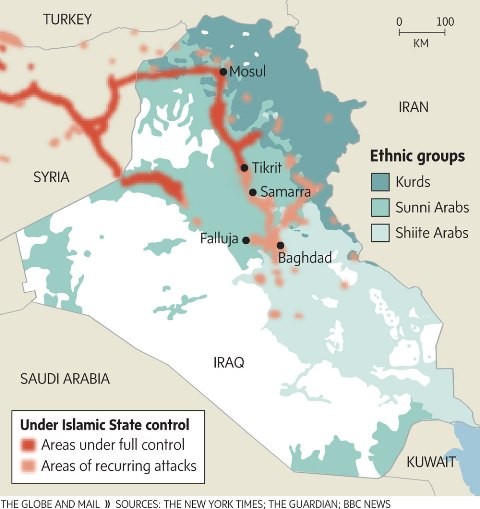
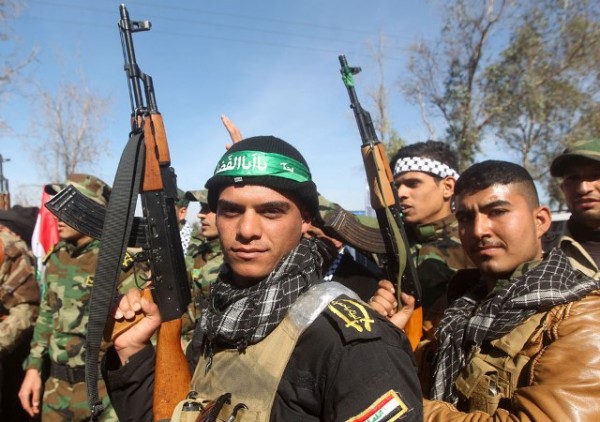
Iraqi Shiite fighters celebrate to mark the liberation of Diyala province from the Islamic State on February 2, 2015. (Ahmad Al-Rubaye/Getty Images)

A Kurdish Peshmerga fighter takes up position with his weapon as he keeps watch, on the outskirts of Mosul on Jan. 26, 2015. (Azad Lashkari/Reuters)
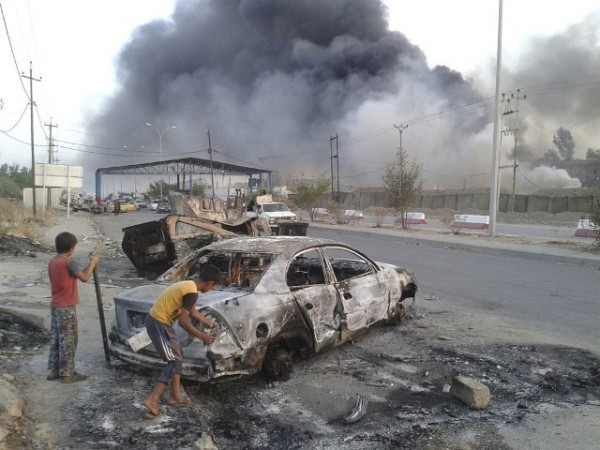
Civilian children stand next to a burnt vehicle during clashes between Iraqi security forces and al Qaeda-linked Islamic State in Iraq and the Levant (ISIL) in the northern Iraq city of Mosul, June 10, 2014. (Reuters)
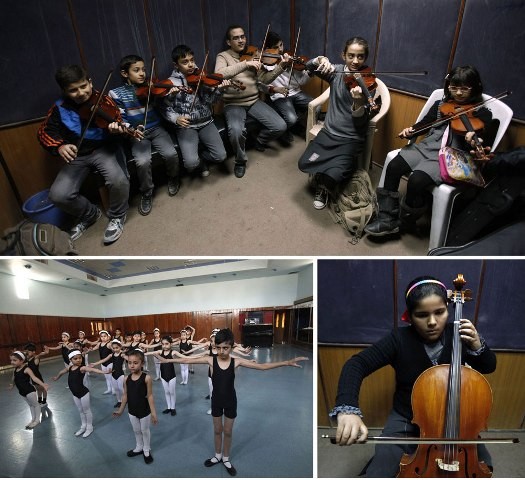
The Music and Ballet School of Baghdad, a bastion of secularism, has seen enrolment drop 25 per cent in the past year, as educated professionals leave Iraq. (Ahmed Saad / For The Globe and Mail)
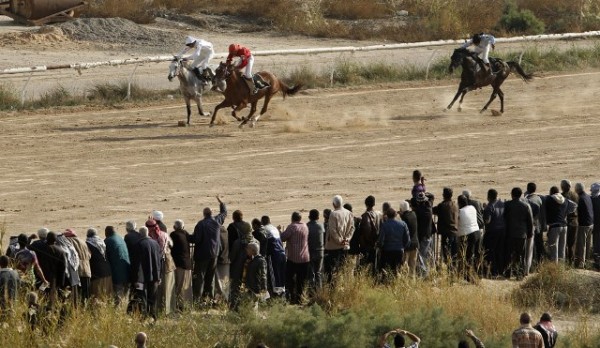
Residents watch a race in Baghdad s Amiriya district. (Ahmed Saad / For The Globe and Mail)
|